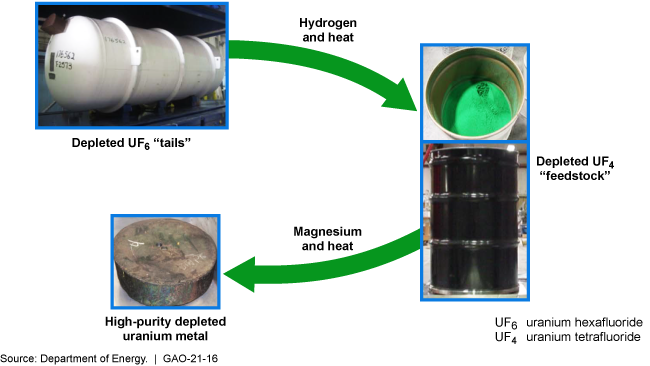Nuclear Weapons: NNSA Plans to Modernize Critical Depleted Uranium Capabilities and Improve Program Management
Fast Facts
To maintain and modernize the U.S. nuclear weapons stockpile, the National Nuclear Security Administration needs a supply of depleted uranium metal (a by-product of enriching uranium to make nuclear fuel) to manufacture nuclear weapon components. But, its supply is dwindling, and critical manufacturing capabilities have been dormant.
NNSA plans to:
upgrade existing Department of Energy facilities and use a commercial vendor to re-establish a supply of this metal
modernize and restart manufacturing capabilities
Delays in these plans could slow or halt nuclear stockpile modernization programs—worth billions of dollars—in the next decade.
Converting the by-products of uranium enrichment processes into high-purity depleted uranium metal

Highlights
What GAO Found
The Department of Energy's (DOE) National Nuclear Security Administration (NNSA) is taking steps to establish a new supply of high-purity depleted uranium (DU) to modernize the nuclear weapons stockpile. DU for fabrication of weapons components must be in high-purity metal form. Producing DU metal generally involves first converting a byproduct of uranium enrichment, known as “tails,” into a salt “feedstock,” which is then converted into metal. (See figure.) To reestablish a supply of feedstock, NNSA plans to install conversion equipment in an existing facility at DOE's Portsmouth site in Ohio. DOE initially estimated costs of $12 million to $18 million to design and install the equipment, with operations beginning in fiscal year 2022. However, in March 2020, NNSA requested an increase in conversion capacity, and an updated proposal in July 2020 estimated costs of $38 million to $48 million and a slight delay to the start of operations. NNSA plans to convert the feedstock into DU metal using a commercial vendor at a cost of about $27 million annually.
Conversion of a Byproduct of Uranium Enrichment into Metal 
NNSA is also taking steps to reestablish and modernize DU component manufacturing capabilities, but it risks delays that could affect the timelines of nuclear stockpile modernization programs, according to officials. NNSA has reestablished processes for manufacturing some DU components but not for components made with a DU-niobium alloy, a material for which NNSA has no alternative. Thus, restarting the alloying process—a complicated, resource-intensive process that has not been done in over a decade—is NNSA's top priority for DU and presents a very high risk to timely supply of components for certain nuclear stockpile modernization programs, according to NNSA documents and officials. NNSA is also developing more efficient manufacturing technologies, in part because the current alloyed component process wastes a very high percentage of the materials and NNSA cannot recycle the waste. For its DU activities, NNSA has requested an increase in funding from about $61 million in fiscal year 2020 to about $131 million in fiscal year 2021.
Until recently, NNSA had not managed DU activities as a coherent program in a manner fully consistent with NNSA program management policies. Since October 2019, however, NNSA has taken actions to improve program management. For example, NNSA has consolidated management and funding sources for DU activities under a new office and DU Modernization program with the goal of better coordinating across the nuclear security enterprise. Further, NNSA appointed two dedicated Federal Program Managers to gather and organize information for required program management and planning documents.
Why GAO Did This Study
High-purity DU is an important strategic material for ongoing and planned modernizations of the nation's nuclear weapons stockpile. However, according to NNSA estimates, NNSA has a very limited supply of DU feedstock, and its current supply of DU metal will be exhausted in the late 2020s. NNSA also does not have the full range of capabilities needed to manufacture DU into weapon components needed for modernizing the stockpile. GAO has previously reported that NNSA has experienced challenges in restarting some technical manufacturing processes.
A Senate committee report accompanying a bill for the National Defense Authorization Act for Fiscal Year 2017 included a provision for GAO to examine NNSA's management of DU for nuclear stockpile modernization. GAO's report examines (1) the status of NNSA's efforts to obtain the necessary quantities of DU to meet stockpile modernization requirements; (2) the status of NNSA efforts to develop DU component manufacturing capabilities to meet stockpile modernization requirements; and (3) the extent to which NNSA is managing DU activities as a program, consistent with agency policy.
GAO reviewed relevant agency documents; interviewed NNSA officials and contractor representatives; and conducted site visits at headquarters and at research, development, and production locations.
For more information, contact Allison Bawden at (202) 512-3841 or bawdena@gao.gov.
